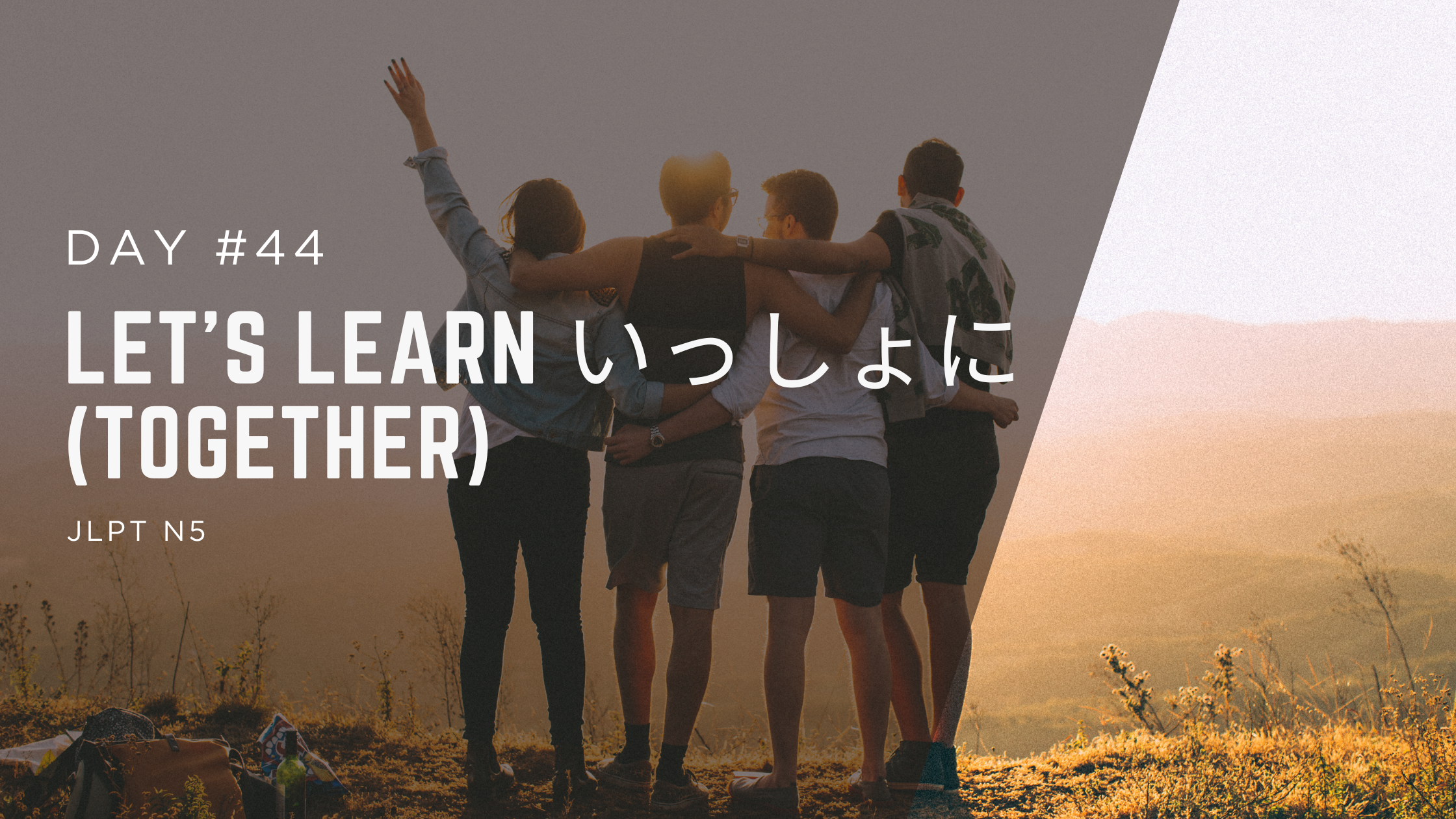Welcome back, language warriors! You’re rocking Day 44 of our 100-day challenge to conquer JLPT N5, and that’s nearly halfway to your goal of speaking Japanese with confidence.
Today, we’re diving into a super simple yet powerful phrase: いっしょに (issho ni), meaning “together” or “with.” Let’s do this together – いっしょに!
Main Lesson: Breaking Down いっしょに Step by Step
Grammar Rules
いっしょに (issho ni) is a phrase that means “together” or “with someone.” It’s a versatile expression used to indicate doing something alongside others, making it perfect for social situations.
Structure:
いっしょに is placed after a noun (like a person’s name) or pronoun, followed by a verb to describe the action you’re doing together.
Example:
たなかさんと いっしょに たべます。 (Tanaka-san to issho ni tabemasu.)
– I eat with Tanaka-san.
Particle “ni”:
The に here indicates the manner or context (“together”). It’s not the same as に for direction or time (like Day 30’s lessons), but don’t worry – context makes it clear.
When to Use:
Use it for group activities, invitations, or describing shared actions. It’s common in daily life, like suggesting to study or eat together.
This phrase pairs beautifully with yesterday’s ましょう (let’s ~), as in いっしょに べんきょう しましょう (Let’s study together).
Vocabulary List
To make examples practical, here’s a list of N5-level verbs and nouns to use with いっしょに, organized in tables for clarity.
| Japanese (ひらがな) | Romaji | English |
|---|---|---|
| ともだち | tomodachi | friend |
| せんせい | sensei | teacher |
| かぞく | kazoku | family |
| こうえん | kouen | park |
| がっこう | gakkou | school |
| えき | eki | station |
Examples
Let’s see いっしょに in action!
ともだちと いっしょに こうえんに いきます。
(Tomodachi to issho ni kouen ni ikimasu.)
– I go to the park with my friend.
いっしょに すしを たべましょう。
(Issho ni sushi o tabemashou.)
– Let’s eat sushi together.
せんせいと いっしょに にほんごを べんきょう します。
(Sensei to issho ni nihongo o benkyou shimasu.)
– I study Japanese with the teacher.
かぞくと いっしょに えいがを みます。
(Kazoku to issho ni eiga o mimasu.)
– I watch a movie with my family.
いっしょに コーヒーを のみましょうか。
(Issho ni koohii o nomimashou ka.)
– Shall we drink coffee together?
たなかさんと いっしょに えきに きます。
(Tanaka-san to issho ni eki ni kimasu.)
– I come to the station with Tanaka-san.
いっしょに にほんごを はなしましょう。
(Issho ni nihongo o hanashimashou.)
– Let’s speak Japanese together.
ともだちと いっしょに あそびます。
(Tomodachi to issho ni asobimasu.)
– I play with my friend.
いっしょに ケーキを つくります。
(Issho ni keeki o tsukurimasu.)
– We make a cake together.
かぞくと いっしょに こうえんを あるきます。
(Kazoku to issho ni kouen o arukimasu.)
– I walk in the park with my family.
Common Mistakes
English speakers often stumble when using いっしょに because English “together” is looser in structure. Here’s how to avoid common traps:
Wrong Particle Use: English speakers might use に alone or skip particles.
Wrong: ともだち いっしょ たべます。
Correct: ともだち と いっしょ に たべます。
These tips will keep your Japanese natural and N5-ready. Mistakes are just stepping stones – keep practicing!
Conclusion: Wrapping Up and Looking Ahead
Great job on Day 44! You’ve mastered いっしょに, a key phrase for saying “together” in Japanese, perfect for inviting friends or describing group activities.
Consistency is your superpower – just 15 minutes a day brings you closer to fluency. Loving this journey to learn Japanese for beginners?
Subscribe for daily lessons or share this post with your study buddy. Try making your own いっしょに sentence in the comments – let’s learn together! がんばって!



